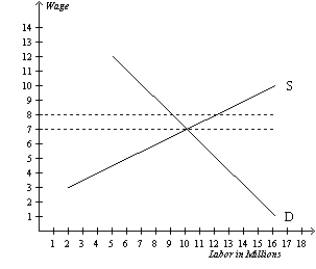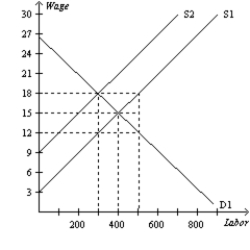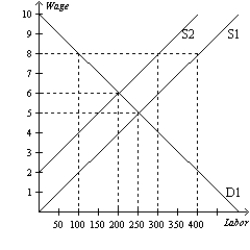A) is unlikely to find evidence of wage differentials.
B) can provide strong evidence of labor market discrimination.
C) is likely to misinterpret apparent evidence of labor market discrimination.
D) is accepted as superior to empirical work that does correct for differences in productivity of workers.
F) A) and D)
Correct Answer

verified
Correct Answer
verified
Multiple Choice
Figure 19-1  -Refer to Figure 19-1. If the minimum wage in this market is $8, then
-Refer to Figure 19-1. If the minimum wage in this market is $8, then
A) employment is 10 million
B) employment is 12 million
C) there is a surplus of 1 million workers
D) there is a surplus of 3 million workers
F) A) and B)
Correct Answer

verified
Correct Answer
verified
Multiple Choice
In recent years, the amount of international trade in which the United States engages has
A) increased, raising domestic demand for unskilled labor.
B) increased, reducing domestic demand for unskilled labor.
C) decreased, raising domestic demand for unskilled labor.
D) decreased, reducing domestic demand for unskilled labor.
F) A) and C)
Correct Answer

verified
Correct Answer
verified
Short Answer
Figure 19-7  -Refer to Figure 19-7. The figure shows labor demand and labor supply in a non-unionized labor market. If the current labor demand is D1 and the current labor supply is S1, when a minimum wage of $18 per hour is imposed in this market, how many unemployed workers result?
-Refer to Figure 19-7. The figure shows labor demand and labor supply in a non-unionized labor market. If the current labor demand is D1 and the current labor supply is S1, when a minimum wage of $18 per hour is imposed in this market, how many unemployed workers result?
Correct Answer

verified
Correct Answer
verified
True/False
One hypothesis to explain the changing gap in wages between unskilled and skilled workers in the United States is that international trade has altered the relative demands for skilled and unskilled workers.
B) False
Correct Answer

verified
Correct Answer
verified
Multiple Choice
Scenario 19-2 Travis, a student at a community college, is considering what he should do for summer employment. Two recruiters show up at his school in search of summer workers. Recruiter A is looking for workers to help a disaster relief agency distribute food aid in Africa. Recruiter B is looking for custodial help to clean motel rooms in a motel located near the entrance to a famous national park. -Refer to Scenario 19-2. Travis is carefully considering the options that each recruiter presents. On the basis of knowledge obtained in his economics class, Travis concludes that
A) if the motel job also requires an ability to do general plumbing repairs, the wage offer will be higher than otherwise.
B) if the food distribution job has a requirement for special training or certification, the wage offer will be lower than otherwise.
C) if the food distribution job exposes him to the Ebola virus, the wage will be lower.
D) if the motel job involves substantial amounts of driving for supplies, the wage offer will be lower than otherwise.
F) C) and D)
Correct Answer

verified
Correct Answer
verified
Multiple Choice
Economists generally agree that
A) human capital theory provides the best explanation of discriminatory practices.
B) differences in average wages do not by themselves provide conclusive evidence about the magnitude of discrimination in labor markets.
C) discrimination is exclusively an economic, rather than political, phenomenon.
D) most of the wage differentials observed in the U.S. economy are due to discrimination.
F) C) and D)
Correct Answer

verified
Correct Answer
verified
Short Answer
Table 19-2
 Source: US Census Bureau and Mankiw's calculations
-Refer to Table 19-2. In 2011, on average how much more income would a man with a college degree earn than a man with a high school degree?
Source: US Census Bureau and Mankiw's calculations
-Refer to Table 19-2. In 2011, on average how much more income would a man with a college degree earn than a man with a high school degree?
Correct Answer

verified
Correct Answer
verified
Multiple Choice
In general, the higher a person's education level,
A) the higher the person's earnings.
B) the more physically attractive the person is likely to be.
C) the more socially outgoing the person is likely to be.
D) All of the above are correct.
F) B) and C)
Correct Answer

verified
Correct Answer
verified
True/False
Labor-market discrimination based solely on age is illegal in the United States.
B) False
Correct Answer

verified
Correct Answer
verified
True/False
The signaling theory of education maintains that workers who complete specific levels of education signal their high productivity to potential employers.
B) False
Correct Answer

verified
Correct Answer
verified
Multiple Choice
Differences in human capital are likely to
A) be unrelated to wage rate differences across gender classifications, since both men and women are required to complete requirements for a high school diploma.
B) be most helpful in explaining age discrimination, but unhelpful in explaining race discrimination.
C) explain some of the differences in average wage rates across age classifications.
D) explain all of the differences in average wage rates across gender classifications.
F) A) and B)
Correct Answer

verified
Correct Answer
verified
Multiple Choice
According to evidence provided by the U.S. government, the median black
A) woman is paid roughly the same as the median white woman.
B) woman is paid roughly the same as the median black man.
C) man is paid 21 percent less than the median white man.
D) All of the above are correct.
F) A) and B)
Correct Answer

verified
Correct Answer
verified
Multiple Choice
Over the past several years, the earnings gap between high-skilled and low-skilled workers has
A) increased.
B) decreased.
C) remained constant.
D) first increased by a small percent, then decreased by a large percent.
F) A) and B)
Correct Answer

verified
Correct Answer
verified
Short Answer
Many economists believe that competitive, market economies provide a natural antidote to employer discrimination known as the
Correct Answer

verified
Correct Answer
verified
Multiple Choice
Two economists created fake resumes with either common African-American names such as Lakisha and Jamal or common white names such as Emily and Greg. After sending them to potential employers with "Help Wanted" ads in Boston and Chicago newspapers, they found that
A) black employees earned 50 percent less than white employees in Chicago but that blacks and whites had similar wages in Boston.
B) black employees earned 50 percent less than white employees in Boston but that blacks and whites had similar wages in Chicago.
C) job applicants with white names received 50 percent more phone calls from interested employers.
D) job applicants with white names received 7 percent more phone calls from interested employers.
F) A) and B)
Correct Answer

verified
Correct Answer
verified
Multiple Choice
Studies of discrimination in baseball suggest that black players
A) suffered from discriminatory wage differentials several decades ago and those wage differentials persist today.
B) suffered from discriminatory wage differentials several decades ago but those wage differentials have been eliminated.
C) did not suffer from discriminatory wage differentials several decades ago but in recent years wage differentials have become evident.
D) did not suffer from discriminatory wage differentials in the past and they do not suffer from wage differentials today.
F) A) and D)
Correct Answer

verified
Correct Answer
verified
Multiple Choice
Figure 19-5  -Refer to Figure 19-5. Given demand for labor, D1, and supply of labor, S2, what is the surplus of labor if a minimum wage of $8 per hour is imposed on this market?
-Refer to Figure 19-5. Given demand for labor, D1, and supply of labor, S2, what is the surplus of labor if a minimum wage of $8 per hour is imposed on this market?
A) 100
B) 200
C) 300
D) 400
F) None of the above
Correct Answer

verified
Correct Answer
verified
Multiple Choice
Which of the following statements accurately explains the superstar phenomenon in wages?
A) Better carpenters earn more than average carpenters because people are willing to pay higher prices for higher-quality work.
B) The more productive an author is, the more books she can write each year, so the more she earns.
C) Talented movie stars earn more than equally talented mechanics because technology allows the delivery of the services provided by the movie stars to all interested customers.
D) Athletes get paid for performing services that everyday people perform as hobbies.
F) C) and D)
Correct Answer

verified
Correct Answer
verified
Multiple Choice
In empirical analyses of factors that help explain wages,
A) effort and ability are not likely to contribute to large differences in wages in the U.S. economy.
B) economists typically find that measurable factors explain less than half of the variation in wages.
C) economists typically find few factors that are not explicitly measurable.
D) unmeasurable influences on wage differences are found to be quite small.
F) A) and B)
Correct Answer

verified
Correct Answer
verified
Showing 401 - 420 of 490
Related Exams